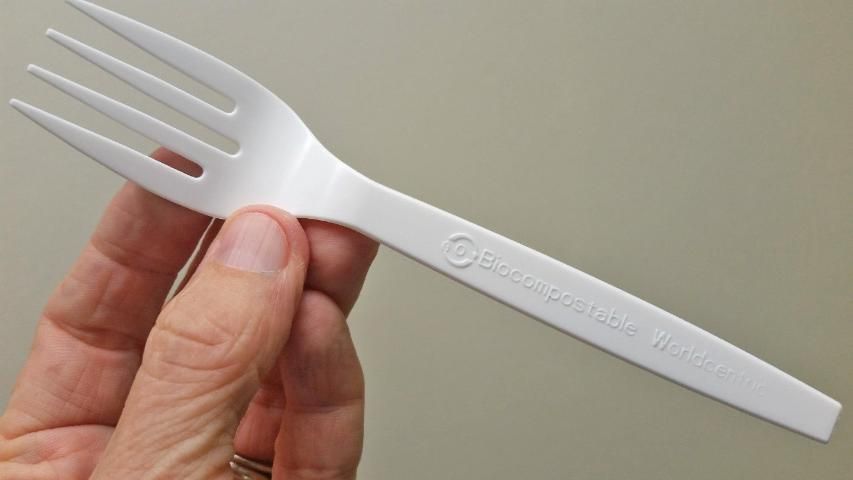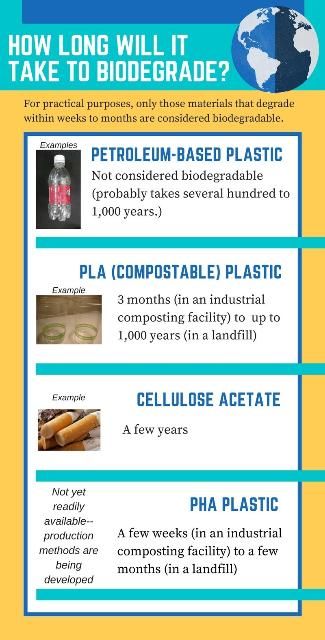Most modern-day plastics are made from petroleum. However, it is possible to make several different types of plastics from plant or even bacterial sources. This seems to offer hope that these bioplastics will be more environmentally friendly than their petroleum counterparts. The reality is that bioplastics and their contribution to sustainability are complicated issues. It's important that consumers understand the properties of different types of bioplastics, what happens when they are disposed of, and whether bioplastics can truly reduce pressure on the environment.
What are bioplastics?
Many terms are used to describe types of plastics that are made from plants or other biological materials. Some terms are used interchangeably; others actually have subtle differences. The terms "bioplastic," "biopolymer," and "bio-based plastic" are all used to describe a plastic substance made from plant material. The bioplastics that we will discuss are:
- Cellulose acetate
- Bio-derived plastics
- Polylactic acid, or PLA
- Polyhydroxyalkanoate, or PHA plastic
What is meant by the term "biodegradable?"
Biodegradability refers to the ability of something to decompose with the help of microbes into harmless substances such as carbon dioxide and water. This process is usually fastest in the presence of oxygen and water and at warmer temperatures. All carbon-based, or organic, matter will eventually biodegrade. This includes plants and animals and even certain petroleum-based plastics. The process can also be called "composting," but composting is human-mediated. There are two types of composting: "industrial composting " and "home composting." Industrial composting occurs at a much higher temperature than is achieved by composting at home.
The rate of biodegradation of different organic materials can vary greatly. The environment and timeframe must be specified when deciding whether or not to call something "biodegradable" or "compostable." In general, the degradation process should take less than a year under certain environmental conditions for the item to be considered biodegradable.
What are some types of bioplastics?
- Cellulose acetate
Cellulose acetate is a type of bioplastic commonly used to make fibers like those used in cigarette filters or acetate fabric. It has also been used to make photographic film. Cellulose acetate is not the same thing as cellulose, which is a naturally tough, insoluble fiber that makes up part of the cell wall in plants. Some ropes and thread are made from cellulose fibers of cotton or hemp. Cellulose acetate is a synthetic substance made by chemically reacting cellulose fibers with acetic acid or acetic anhydride. The resulting product is a thermoplastic, meaning it can be re-shaped by heating and will melt if it gets hot enough. Cellulose acetate is generally considered to be biodegradable, but the time it takes to decompose can range from several months to several years. Its degradation rate is highly dependent on the chemical process used to produce the cellulose acetate.
- Bio-derived plastics
Bio-derived or bio-based plastics are bioplastics that are not necessarily considered biodegradable. These plastics have the same chemical structure as petroleum-based plastics, but are made from plant sources. Their names mimic the type of petroleum-based plastic, with the term "bio" added. For example, Bio-PET is used to make plant-based beverage bottles. The petroleum-based equivalent is polyethylene terephthalate, or PET. Both PET and Bio-PET can be recycled at facilities that accept plastics with the recycle code #1. Bio-polyethylene (Bio-PE) and bio-polypropylene (Bio-PP) are two other types of bio-derived plastic. They can also be recycled following the same rules as their petroleum-based equivalents. The bio-derived plastic will have the same recycling code as its counterpart.
- PLA plastic
Some plant-based plastics are labeled as biodegradable or compostable. These plastics are most often made from sugar cane or corn starch, although they can also be made from potatoes or other plants. A common type of this plastic is referred to as polylactic acid, or PLA. PLA is one of the plastics commonly used for 3-D printing, cold beverage cups and utensils, cardstock and cardboard adhesives, multilayer packaging, and extruded plastic coatings on paper products such as paper cups and take-out containers.
While PLA plastic is called compostable, it will not biodegrade in the environment or in a backyard compost pile. Products made from PLA will only readily break down in a commercial composting facility, where they are exposed to high-heat conditions in the presence of water and air. The higher temperature is often necessary to facilitate the first step of degradation of bioplastics. The heat breaks the repeating chemical backbone of the plastic into smaller components that microorganisms may then metabolize. Unfortunately, these industrial facilities are not available in Florida.
PLA plastic items cannot be recycled. They should not be placed in recycling bins. Because PLA has a very low melting point, this type of plastic can cause problems if added to the recycling stream.

Credit: Maia McGuire, UF/IFAS
Who sets the standards for what is and is not biodegradable or compostable?
The most recognizable international standards come from two international agencies, the American Standards for Testing and Materials, or ASTM, and the International Organization for Standardization, or ISO.
Plastics that claim to be compostable should also include labeling that says what standard the product complies with. For example, they may say that they comply with ASTM D6400 or ASTM D68681. One requirement of the ASTM standards is that 90% of the organic carbon in the product will be converted to carbon dioxide within 180 days in an industrial composting facility. In other words, the product will not compost in a home compost heap. Compostable bioplastics require the high heat and oxygen available in industrial composting facilities to properly degrade. If the products are not composted under these conditions, they will likely persist in the environment for decades or longer.
In the United States, the Federal Trade Commission provides guidance about labeling of biodegradable or compostable plastics. It states, "Marketers should qualify compostable claims if the product can't be composted at home safely or in a timely way. Marketers also should qualify a claim that a product can be composted in a municipal or institutional facility if the facilities aren't available to a substantial majority of consumers."
Are there any bioplastics that will biodegrade on their own in the environment?
A unique group of bioplastics is referred to as PHA (polyhydroxyalkanoate) plastic. PHA is made naturally as an energy storage product by certain bacteria. The chemical structure and properties of the PHA vary depending on the type of bacterium, as well as the fatty acids used as the source material. PHA is a thermoplastic, but unlike many other plastics, it is fairly resistant to ultraviolet light. It is also biodegradable and can be manufactured to degrade under different environmental conditions. For example, some PHA plastic can biodegrade without the presence of oxygen. PHA can be brittle, but its mechanical properties can be manipulated by blending the PHA with plasticizers.
The biggest limitation in the production of PHA is cost. It is difficult to produce in large quantities economically enough to compete with petroleum-based plastics. There have been a few attempts to commercially produce PHA products, but those products were not able to be sustained. Another limitation is that PHA is white or cream in color. Many manufacturers, however, desire clear plastic material, especially for transparent packaging.
Are plant-based plastics more environmentally friendly than petroleum-based plastics?
Whether made from petroleum or plants, plastics that have similar chemical compositions will have similar properties. Both may have chemicals added to them, called plasticizers or additives, to make them more flexible or stiffer, depending on the application. Many plasticizers, such as glycerol, have no toxicity. However, the commonly used plasticizers called phthalates may affect hormone metabolism or regulation. In the ocean, harmful chemicals known as persistent organic pollutants are likely to be attracted to both groups. This can be a problem when toxin-laden plastic particles find their way into marine food webs
This information is intended to help consumers make choices about using bioplastics. In most cases, selecting a bioplastic product will cost more money than the petroleum-based plastic alternative. Bioplastics such as bio-PP, bio-PE, or bio-PET may help reduce greenhouse gas emissions as compared to traditional plastics because no petroleum is used in their production. However, they provide no environmental benefit once discarded. Unless a plastic is certified as home compostable or biodegradable by a reputable agency, a reusable, washable alternative is often the best choice. Home compostable materials may not decompose in a landfill.
1ASTM D6400: standards for plastics and products made from plastics that are designed to be composted in municipal and industrial aerobic composting facilities. ASTM D6868: standards for biodegradable plastic coatings where the product or package is designed to be composted in municipal and industrial aerobic composting facilities.

Credit: Soda bottle by Maia McGuire; PLA cups photo by Majiscup Paper Cup Museum https://creativecommons.org/licenses/by-nc-nd/2.0/legalcode; cigarette butts by pixabay
References
Latini, G., A. Verrotti, and C. De Felice. "DI-2-Ethylhexyl Phthalate and Endocrine Disruption: A Review." Current Drug Targets - Immune, Endocrine & Metabolic Disorders 2004 4 (1): 37–40. https://doi.org/10.2174/1568008043340017
Puls, J., S. A. Wilson, and D. Hölter. "Degradation of Cellulose Acetate-Based Materials: A Review." J Polym Environ 2011 19: 152. https://doi.org/10.1007/s10924-010-0258-0
Kenny, S. T., J. N. Runic, W. Kaminsky, T. Woods, R. P. Babu, C. M. Keely, W. Blau, and K. E. Connor. 2008. "Up-Cycling of PET (Polyethylene Terephthalate) to the Biodegradable Plastic PHA (Polyhydroxyalkanoate)." Environmental Science & Technology 42 (20): 7696–7701 DOI: 10.1021/es801010e